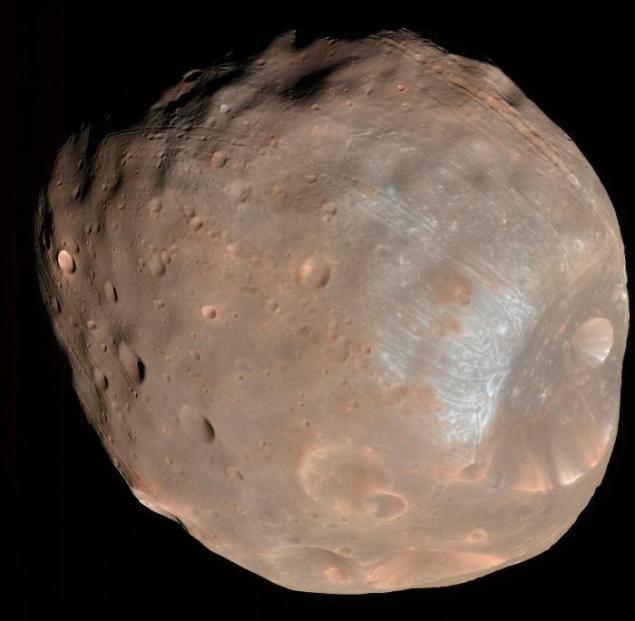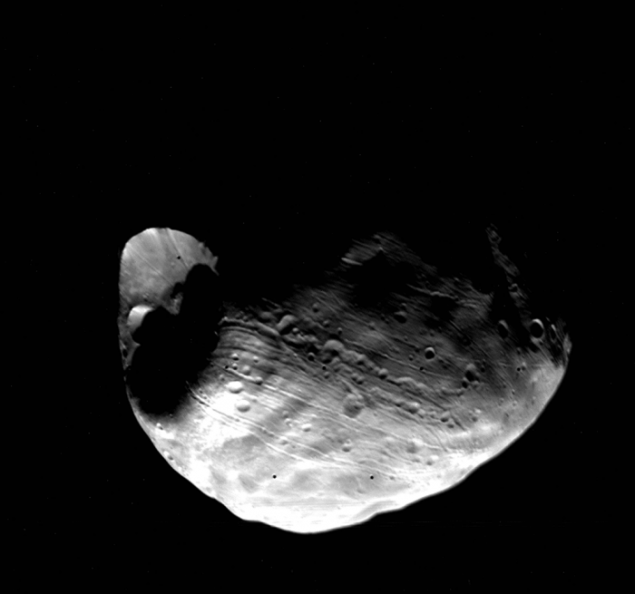Phobos and Deimos: captured asteroids or fragments of Mars?
 Bashny.Net
Bashny.Net
In the inner solar system except the Moon has only two satellites Phobos and Deimos. These names come from Greek mythology and means "fear" and "horror". Phobos and Deimos were the sons of the god of war Ares, which corresponds to Mars in Roman mythology.
Two independent research groups have modeled the very birth of satellites and concluded that Phobos and Deimos may arise as a result of a powerful collision object with Mars.

© NASA / JPL-Caltech / University of Arizona i> sup>
There are three popular theories of the origin of the satellites in the solar system.
The first states that the discs of dust and dirt around the planet grouped in small clusters to the current size of the satellites, just as the planets formed from the accretion disk around the sun.
In an alternative scenario, the satellites are asteroids captured and pulled into the orbit of the planet's gravitational force. Until recently, it was considered the most likely hypothesis with regard to the origin of Phobos and Deimos.
The third option - the collision of the planet with a large celestial body. If a sufficient amount of the substance will be discarded in the near-the-space, it may result in a satellite. That is, according to current ideas, the moon appeared.
Dimensions of Phobos and Deimos are typical asteroids. They are dotted with craters and surface kartofelevidnaya form is also spoken in favor of the asteroid hypothesis. However, there are several factors that are not consistent with this version of the origin of the moons of Mars. Previously it was thought that the composition, density and optical properties of the surface of both celestial bodies indicate their asteroid past. However, data from the European interplanetary station «Mars Express» and American «Mars Global Surveyor» gave rise to doubts.
The orbits of the moons of Mars are circular, to be expected in the case of origin from the disk material. This captured asteroids orbit should be elliptical. In addition, the equatorial rotation velocity of Mars is quite high. What could be the cause of the acceleration of rotation of the planet? Maybe hit the outside of a celestial body?
Such a collision could snatch and throw into space the starting material for Phobos and Deimos, which, among other things, explains the good and the position of the orbital plane of the two satellites.

© NASA / Viking 1 Orbiter ( CC0 ) i> sup> < br />
Guess a collision with a celestial body of Mars is not new. Back in 1994, the American geologist Robert Craddock from the National Air and Space Museum of the Smithsonian Institution was trying to convince colleagues in this theory in one of the scientific conferences. The report was met with skepticism. So much so that the scientific article was rejected by the scientist scientific journals "Nature" and "Science".
Fortunately, thanks to the new data obtained by the Mars mission, Craddock interest in the idea was revived, and in 2011 he was able to publish his article.
The revival of interest served as an incentive for the two research teams that tested the hypothesis Craddock on computer models. The first group worked at the University of California at Berkeley under the direction of Robert Sitrena (Citron), the second - at a research institute in Boulder under the direction of Robin Kenapa.
The main candidate for the impact crater was the Great Northern Plain (Vastitas Borealis), reaching across 7,700 km.
Researchers have lost a number of possible scenarios, varying the angle of incidence, mass and velocity of a celestial body, presumably confronted with Mars. As a result of the simulated collision, one of the torn wreckage returned back to Mars by the force of gravity, while others received a boost of sufficient strength to fly into space, and another part remained in the orbit of the planet. The simulation showed that the mass of these fragments is sufficient for the formation of Phobos and Deimos.
Related Links:
The scientific article: Are Phobos and Deimos the result of a giant impact?
Source: geektimes.ru/post/253620/
Two independent research groups have modeled the very birth of satellites and concluded that Phobos and Deimos may arise as a result of a powerful collision object with Mars.

© NASA / JPL-Caltech / University of Arizona i> sup>
There are three popular theories of the origin of the satellites in the solar system.
The first states that the discs of dust and dirt around the planet grouped in small clusters to the current size of the satellites, just as the planets formed from the accretion disk around the sun.
In an alternative scenario, the satellites are asteroids captured and pulled into the orbit of the planet's gravitational force. Until recently, it was considered the most likely hypothesis with regard to the origin of Phobos and Deimos.
The third option - the collision of the planet with a large celestial body. If a sufficient amount of the substance will be discarded in the near-the-space, it may result in a satellite. That is, according to current ideas, the moon appeared.
Dimensions of Phobos and Deimos are typical asteroids. They are dotted with craters and surface kartofelevidnaya form is also spoken in favor of the asteroid hypothesis. However, there are several factors that are not consistent with this version of the origin of the moons of Mars. Previously it was thought that the composition, density and optical properties of the surface of both celestial bodies indicate their asteroid past. However, data from the European interplanetary station «Mars Express» and American «Mars Global Surveyor» gave rise to doubts.
The orbits of the moons of Mars are circular, to be expected in the case of origin from the disk material. This captured asteroids orbit should be elliptical. In addition, the equatorial rotation velocity of Mars is quite high. What could be the cause of the acceleration of rotation of the planet? Maybe hit the outside of a celestial body?
Such a collision could snatch and throw into space the starting material for Phobos and Deimos, which, among other things, explains the good and the position of the orbital plane of the two satellites.

© NASA / Viking 1 Orbiter ( CC0 ) i> sup> < br />
Guess a collision with a celestial body of Mars is not new. Back in 1994, the American geologist Robert Craddock from the National Air and Space Museum of the Smithsonian Institution was trying to convince colleagues in this theory in one of the scientific conferences. The report was met with skepticism. So much so that the scientific article was rejected by the scientist scientific journals "Nature" and "Science".
Fortunately, thanks to the new data obtained by the Mars mission, Craddock interest in the idea was revived, and in 2011 he was able to publish his article.
The revival of interest served as an incentive for the two research teams that tested the hypothesis Craddock on computer models. The first group worked at the University of California at Berkeley under the direction of Robert Sitrena (Citron), the second - at a research institute in Boulder under the direction of Robin Kenapa.
The main candidate for the impact crater was the Great Northern Plain (Vastitas Borealis), reaching across 7,700 km.
Researchers have lost a number of possible scenarios, varying the angle of incidence, mass and velocity of a celestial body, presumably confronted with Mars. As a result of the simulated collision, one of the torn wreckage returned back to Mars by the force of gravity, while others received a boost of sufficient strength to fly into space, and another part remained in the orbit of the planet. The simulation showed that the mass of these fragments is sufficient for the formation of Phobos and Deimos.
Related Links:
The scientific article: Are Phobos and Deimos the result of a giant impact?
Source: geektimes.ru/post/253620/
Tags
See also
Pindos - a breed of horses
Debbie Shapiro: All that You hold in your mind will reflect in Your body
New encounter of comet Siding Spring
Sunflower Solar Sunflower
Stove Board – a hundred years is not a term
Mysterious Island Solar System
Who, when and how is going to fly to Mars
Interesting facts about Mars

















